|
Greg: How were your early guitars tuned compared to
standard guitar tuning?
Emmett: From '61 to '63 I kept extending the guitar scale
length and experimented with 7 strings. Up until '65 I kept adding
high 4ths at the first string position to extend my chords in what
I thought was modern harmony.
In the process, I had to drop the aggregate tuning each time so as
not to snap the newly acquired high 4th. I was always interested in
the intervallic relationships rather than the lettered tuning or
actual key of my song arrangements.
By '65 I had "conceptually" added three 4th intervals at the high
end of my home built 8-string guitar tuning, and each time the guitar
major 3rd would shuffle down lower in the sequence, that is, from
strings 2 and 3 finally to strings 5 and 6.
Greg: When did you finally settle on the scale length?
Emmett: In '64 I built my first 34" long scale 8-string
guitar in the Air Force wood shop at SAC HQ in Omaha and its tuning
was: 1-high D, 2-A, 3-E, 4-B, 5-F#, 6-D, 7-A and 8-low E.
Thus I retained the guitar's double octave between 1st and 6th
strings, with the high D tensioned quite a bit higher than high E
on the guitar's 25" scale length, and with a low E at the very
low end as on the customary 4-string bass guitar. The guitar's major
3rd was now relegated to a lower register between 5th and 6th strings.
Voila! "modern" chordal extensions in 4ths simply by adding a barre at
the high end of a chord.
Greg: So were you looking for new ways to harmonize chords
or to pick bass lines? What led you to invert strings 6-8?
Emmett: I wanted to make chordal accompanyment as easy as
possible, given the complex jazz progressions I was playing together
with jazz melody lines, and with so many strings on my guitar, I found
the bass element easier to negotiate if those strings were somewhere
in the middle of the sequence. It also opened up two sets of chordal
strings, one in 4ths and one in 5ths. Around '67 I created the bass
5ths tuning on that Air Force guitar simply by dropping the D at the
6th position down an octave, extending my overall range by a whole
step, and raising the E at the 8th position up an octave. The A was
left as is, thus all lettered notes remained the same. Soon after,
I added a 9th string (B, a 5th above the 8th E).
Greg: So the inverted 5ths were already there whan you made
your tapping discoveries...
Emmett: Yes, I discovered two-handed tapping on nine strings
on the evening of August 26th, 1969, although there were actually 10 strings
on my long scale, spoon bodied guitar,
the 10th being the "wild string" (you make my heart
sing), a lever operated companion to the highest 1st string.
After this sudden and complete transition to tapping, I dropped all
gadgets, including the "wild string", and soon added a 5th lower G
at the 7th position and another 5th lower C at the 6th position,
raising the remaining D, A and E strings up one octave. (I know,
it's complicated.) This gave the following tuning sequence:
Melody 4ths: 1-high D, 2-A, 3-E, 4-B and 5-F#.
Bass 5ths: 6-low C, 7-G, 8-D, 9-A and 10-E.
Greg: So was the tuning in any way influential in the method
discovery? Or is it just a happy accident that this expanded harmonic
capability for the left hand arose? Were you dividing the instrument
into 5ths for the left and 4ths for the right at the moment of
discovery?
Emmett: I feel there was some relationship between my
4ths/reversed 5ths tuning and the tapping discovery. I had been
picking chords on both the 4th and 5ths with a bass element on the
5ths, plus picking as free a melody line as I could on the 4ths
(given the amount of fingers left over on my one fingering hand).
Chords were voiced on whatever strings were available, often on both
sides at once, 4ths with 5ths. When I started tapping independently
with both hands, I initially kept the same approach - LH bass on the
5ths, LH chords on both 4ths and 5ths, and RH melody (and more chords)
on the 4ths at higher frets.
Greg: So you had your tuning, but early on in production
you made lowered tuning for some of the earlier models, didn't you?
What made you shift it around?
Emmett: I lowered all ten strings by a whole step around the
time I started Stick production in '74. It was a ruthless attempt
to:
- Have slinkier strings for pitch bending like Hendrix and Shankar,
but not lose more volume with yet thinner, "roll your own" melody
strings.
- Bring the bass down to very low Bb. I was ambitious about extending
my range, but I thought the instrument sounded better at my original
10-string tuning, so I raised them back up a whole step in '76
That's my story and I'm stickin' to it.
Greg: Thanks for telling us about it. Though I'll miss the
mystery, I'm happy to have the answer.
|

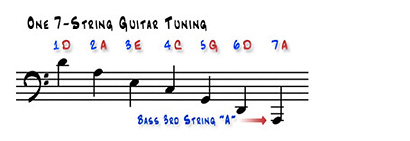
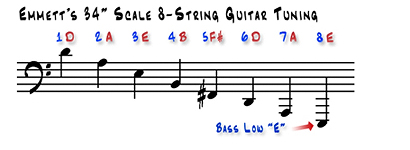
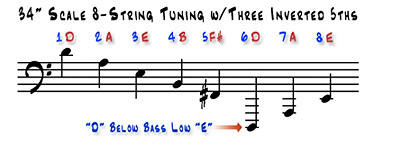
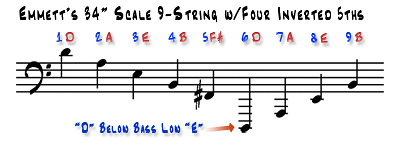
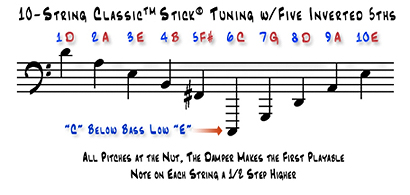
|






